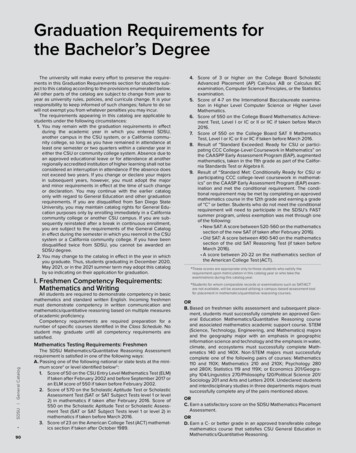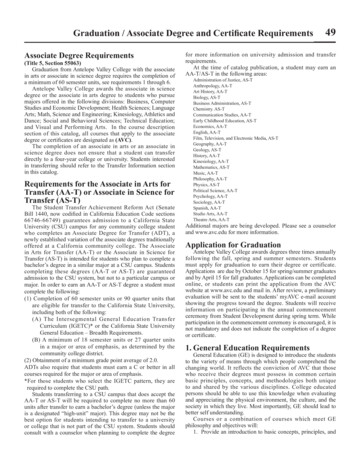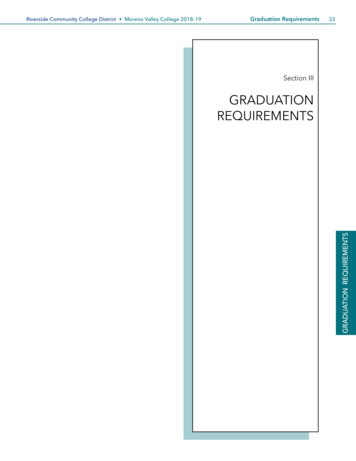
Transcription
ENGLISHVERSIONGENERAL SYSTEMOF GRADUATION
CONTENTSPAGE 3INTRODUCTIONPAGE 4GENERAL SYSTEM OF GRADUATIONPAGE 11SUGGESTED DEGREE SYSTEM FOR AThLETES bETwEEN 4 TO 15 YEARS
In order to unify the teachings, the practice of Jiu-Jitsu and to standardize models of competition, the InternationalBrazilian Jiu-Jitsu Federation (IBJJF) presents this General System of Graduation.To continue the progress and spirit of the recently renewed Jiu Jitsu Book of Rules, launched in January 2012, the GeneralSystem of Graduation strives to enhance the athletes’ understanding of the graduation process from white belt to red belt.The IBJJF has updated the General System of Graduation to provide improvements to our old rules. The biggest improvementis the inclusion of a new grading system for athletes 4 to 15 years of age, which separates each belt rank groups (gray, yellow,orange and green). This new system for athletes under the age of 16 will make the practice of Jiu-Jitsu more exciting andattractive by providing more frequent graduations, which also provides steady advancement throughout the athlete’s career.In regards to the grading system of athlete from 04 to 15 years old, the IBJJF added additional improvements and suggestionsfor professors and instructors. For Example: There are three different ways to grant degrees, which the IBJJF suggests to bedone monthly, trimestrial and quarterly. The purpose of this is to track the Jiu-Jitsu practitioner’s time within every color beltrank.The current General System of Graduation is evolving and may need to be modified over time according to the needs of JiuJitsu. The IBJJF intends to continue working to make the sport easier, more attractive and satisfying for athletes and professors.International Brazilian Jiu-Jitsu Federation3
11.1ARTICLE 1 – bELTSBelt ranks for athletes ages 04 to 15 years old1.White2.Grey and White3.Grey4.Grey and Black5.Yellow and White6.Yellow7.Yellow and Black8.Orange and White9.Orange10. Orange and Black11. Green and White12. Green13. Green and Black1.2Belt ranks for athletes ages 16 years and older1.White2.Blue3.Purple4.Brown5.Black6.Red and Black7.Red and White8.Red4
1.31.3.1Configuration of BeltsBelts – Athletes from 04 to 15 years oldBelts will have from 2.5 cm (0.98 in) to 3.5 cm (1.38 in) wide and one black bar of approximately 10 cm (3.94 in) in lengthpositioned between 2 cm (0.79 in) to 3 cm (1.18 in) in one of the ends. The belt may have only the color of the group or awhite or black stripe in the center along its entire length.Aprox. 10 cm2,5 to 3,5 cm2 to 3 cmABCFrom White Belt to Brown Belt – Athletes starting from 16 years oldBelts will have from 3.5 cm (1.38 in) to 4.5 cm (1.77 in) wide; a black bar of approximately 10 cm (3.94 in) length placedbetween 2 cm (0.79 in) to 3 cm (1.18 in) in one of the ends.2 to 3 cmAprox. 10 cm3,5 to 4,5 cm1.3.25
1.3.3Black BeltBlack belt will have a red bar of approximately 10 cm (3.94 in) in length positioned between 2 cm (0.79 in) to 3 cm (1.18 in) inone of the ends. It will be delineated by two white bars and will receive markings from one to six degrees.Aprox. 10 cm3,5 to 4,5 cm2 to 3 cm1.3.4Red and Black Belt / Red and White BeltMaster’s belts are red and black (7th grade) and red and white (8th grade) intercalated with stripes of 20 cm (7.87 in). The beltswill have a white bar of approximately 15 cm (5.91 in) length placed between 2 (0.79 in) to 3 cm (1.18 in) in one of the endsdelineated by two silver bars in which will receive degrees’ markings in red.Aprox. 15 cm3,5 to 4,5 cm2 to 3 cmRed BeltThe Grand Master’s belt (9th and 10th degrees) will be red. It will have a white bar of approximately 15 cm (5.91 in) lengthplaced between 2 cm (0.79 in) to 3 cm (1.18 in) in one of the ends delineated by two gold bars of 2 cm (0.79 in) which willreceive degrees’ markings in red.2 to 3 cmAprox. 15 cm3,5 to 4,5 cm1.3.56
22.1ARTICLE 2 – MINIMUM AGESMinimum age requirements for athletes between 04 to 15 years oldWhite – Any ageGroup Grey (Gray and White Belt, Gray Belt, Gray and Black Belt) – 4 to 15 yearsGroup Yellow (Yellow and White Belt, Yellow Belt, Yellow and Black Belt) – 7 to 15 yearsGroup Orange (Orange and White Belt, Orange belt, Orange and Black Belt) – 10 to 15 yearsGroup Green (Green and White Belt, Green Belt, Green and Black Belt) – 13 to 15 years2.2Minimum age requirements for athletes starting from 16 years oldWhite – Any ageBlue – 16 years or morePurple – 16 years or moreBrown – 18 years or moreBlack – 19 years or moreRed and black – 50 years or moreRed and white – 57 years or moreRed – 67 years or more2.32.3 - Observations2.3.1The minimum age for the athlete to be eligible to change belt is the age he or she has completed or will complete in thecurrent year, following the formula: CURRENT YEAR - BIRTH YEAR AGE OF THE ATHLETE.2.3.2In the year that the athlete turns 16 years of age, he or she must be placed in the Belt system from the Article 1.1. He or she willbe promoted to the new rank according to the belt he has:White Belt – Remains in White Belt;Grey Belt, Yellow Belt, Orange Belt – turns to Blue Belt;Green Belt – turns Blue or Purple Belt according to professor’s decision.456789WHITEGrey / WhiteGREYGROUPGreyGrey / BlackYellow / WhiteYELLOWGROUPYellowYellow / BlackOrange / WhiteORANGEGROUPOrangeOrange / BlackGreen / WhiteGREENGROUPGreen / BlackGreenBLUEPURPLEBROWNBLACK710 11 12 13 14 15 16 17 18 19 2021.
33.1ARTICLE 3 - MINIMUM PERIODThe graduation of athletes must also meet the following minimum periods of permanence in each color:3.1.1Practitioners between 04 to 15 years old – No minimum period of stay in each belt.3.1.2Athletes between 16 and 17 years oldWhite – No minimum timeBlue – No minimum timePurple – 2 (two) years3.1.3Athletes from 18 years old – White Belt to Brown BeltWhite – no minimum timeBlue – 2 (two) yearsPurple – 1 (one) year and a halfBrown – 1 (one) year3.1.4Athletes from the Back Belt *Black – 31 yearsRed and black – 7 yearsRed and white – 10 yearsRed – undefined3.2*The periods mentioned in this topic are fixed, notminimum and determine how long each practitionershould remain in each belt.Observations3.2.1The period mentioned in the Article 3 should be counted from the day of the registration of the athlete in IBJJF in each belt.3.2.2The time it takes for the athlete graduate from white belt to black belt is up to the athlete’s professor. However, the IBJJFrequires a mandatory minimum amount of time the athlete must spend at each belt level.3.2.3From the black belt graduation on (red and black belt, red and white belt and red belt) the practitioner must meet the mandatory minimum time requirement for each belt rank after black belt graduation date.8
44.1ARTICLE 4 - DEGREE SYSTEMDivision by degrees4.1.1Athletes between 04 to 15 years oldThe IBJJF suggests professors have some way of dividing each belt by degrees.See the suggestions in the exhibit of this Regulation.4.1.2Athletes ages 16 years and olderWhite Belt, Blue Belt, Purple Belt, Brown Belt – They are divided single color belts and 4 degrees.Black Belt – Single color Belt and divided by six (6) degrees.Red and Black Belt – Represents the seventh degree black beltRed and White Belt – Represents the eighth degree black beltRed Belt – Represents the ninth degree black beltNote: Until the brown belt, the adoption of the degree system is up to each professor. However, when a practitioner receivestheir black belt it is mandatory to adopt the degree system defined by IBJJF.4.1.3Athletes from the black belt ranking on (red and black belt, red and white belt and red belt) Every promotion to a new degree in the black belt is only valid starting from the issuance of an IBJJF diploma, after theapplicant meets the basic requirements present in Article 5. The first degree can only be requested after a minimum of three (3) years of the black belt graduation. The second and third grades can be requested only after a minimum period of three (3) years from the previous graduation. The 4th, 5th and 6th grades can be requested only after a minimum period of 5 (five) years from the previous graduation. The 7th and 8th grades (red and black belt) can be requested only after a period of 7 (seven) years from the previousgraduation. The 9th degree (red belt) can only be applied after a minimum period of 10 (ten) years from the previous graduation. The 10th grade (red belt) was given only to the pioneers of Brazilian Jiu-Jitsu, the Gracie brothers: Carlos, Oswaldo, George,Gaston and Helio.Note: The year or years the athlete does not renew his or her membership and/or register an academy with IBJJF will notcount as time towards certifying a degree or degrees.9
55.1ARTICLE 5 – IbJJF bASIC REqUIREMENTS TO ObTAIN ThE bLACk bELT CERTIFICATE AND DEGREESBasic Requirements Must be affiliated to IBJJF in the current year. Must provide First Aid or CPR course certificate Must attend an IBJJF Referee Course within a 12 month period before the date the athlete requests the new degree Must attend at least one of the two requirements below:1. Must be the professor responsible or assistant professor at an academy that has renewed the affiliation through IBJJF inall previous years for the minimum period required for the new graduation.2. Must be an athlete practicing Jiu-Jitsu in an academy that has renewed the registration through IBJJF in all previousyears for the minimum period required for the new graduation and has a professor (in charge) who is a black belt withat least 2 degrees certified by IBJJF. Please Note: The professor that signs the application form also must be theprofessor that promoted the athlete and be a black belt with at least two degrees certified by IBJJF.5.2Observations5.2.1The Black belt certification graduation for each new degree is an individual process that depends on a thorough analysis bythe IBJJF including examination of documents, therefore, there is no set time for its conclusion.5.2.2In countries where there is a local organization or federation linked to IBJJF who is responsible for the certification, it mayrequire additional documents to the basic IBJJF requirements.6ARTICLE 6 - PROFESSORS AND INSTRUCTORS6.1The membership form of an athlete graded in belts of gray, yellow, orange, green, blue, purple and brown must be signed byan IBJJF affiliated black belt.6.2The graduation of an athlete to black belt can only be signed by a black belt instructor that promoted them and must have atleast 2 degrees certified by IBJJF.6.3In countries or regions where there are not enough black belts for the development of the sport, IBJJF will accept purplebelt and brown belt athletes to sign as instructors. Once the minimum number is reached, the use of instructor status willbe suspended.6.3.1Brown belt instructors can only graduate athletes to purple belt and purple belt instructors can only graduate athletesto blue belt.10
GENERAL SYSTEM OF GRADUATIONANNEX ISuggested degree system forathletes between 4 to 15 years old
1ANNEXThe IbJJF suggests three methods of dividing each belt in degrees for practitioners between 04 and 15years. Adoption or not of one of the following methods is at the discretion of each professor.1.1Trimestrial System (every 3 months)For the academies that adopt the degree graduation every three months, the IBJJF suggests three degrees for each belt.The fourth degree will be graduating the athlete to the next belt color according to the images below.1st, 2nd and 3rd MONTH4th, 5th and 6th MONTH7th, 8th and 9th MONTH10th, 11th and 12th MONTHTOTAL: 1 YEARii
1.2Quarterly System (every four months)For the academies that adopt the degree graduation every four months, the IBJJF suggests two degrees for each belt.The third degree will be graduating the athlete to the next belt color according to the images below.1st, 2nd, 3rd and 4th MONTH5th, 6th, 7th and 8th MONTH9th, 10th, 11th and 12th MONTHTOTAL: 1 YEARiii
1.3Monthly SystemFor the academies that adopt the degree graduation every month, the IBJJF suggests 11 degrees for each belt. The 12thdegree will be graduating the athlete to the next belt color. The first four degrees are white, the next four will be red and thelast three will be the color of the next belt, as shown on the image below.1st MONTH7th MONTH2nd MONTH8th MONTH3rd MONTH9th MONTH4th MONTH10th MONTH5th MONTH11th MONTH6th MONTH12th MONTHTOTAL: 1 YEARiv
1.4Degrees system for white belts and white and gray beltsThe IBJJF suggests 1 degree per month in White and Grey and White Belts for thecompletion period of 1 year in two graduations.WHITE BELTGREY/WHITE BELT1st MONTH1st MONTH2nd MONTH2nd MONTH3rd MONTH3rd MONTH4th MONTH4th MONTH5th MONTH5th MONTH6th MONTH6th MONTHTOTAL: 6 MONTHSWHITE GREY BELT/WHITE BELT TOTAL: 1 YEARv
vi
INTERNATIONAL bRAZILIAN JIU-JITSU FEDERATION (IbJJF)RIO DE JANEIRO, BRAZILDECEMBER 2012VERSION 1.0
System of Graduation strives to enhance the athletes’ understanding of the graduation process from white belt to red belt. The IBJJF has updated the General System of Graduation to provide improvements to our old rules. The biggest improvement is the inclusion of a new grading system for athletes 4 to 15 years of age, which separates each belt rank groups (gray, yellow, orange and green .











